The Treasure Hunters by Wetdryvac
September 23rd, 2009 5:48 PMThis is an ongoing task, conducted via craigslist. I'm a scavenger, so much of this I'd be doing anyway - thus I figured I'd sit on the task until a proper treasure hunt area came my way. This happened today. Went to nab greenhouse glass (seriously, greenhouse glass is a treasure) from the house of an older woman whose husband had died. She mentioned in passing that the basement needed some stuff taken out of it. Let the treasure hunt begin!
Today, the big trove was three foot long crates of glass at 8x10 and 11x14 sizing. Enough for a small greenhouse! There's a work bench, a *lot* tools we (my housemate and I) told her she should really look into selling, and whole collection of odds and ends.
We don't get the stained glass materials, but it looks like we will get the lead for the stained glass.
* * *
091709
Dear gods, the table was sodding heavy. 200 pounds, or thereabouts, including two structural steel mill bench support legs. We now have the work-bench in pieces (four drawers, main deck, and a pair of legs) throughout the house. Turning this into a proper treasure will be a matter of cleaning the legs and painting them with rust-proof, scrubbing all surfaces, and oiling it. We may end up using it later as a dining room table when we're completely moved to our new place in Maine. Which, of course, we have yet to buy. Bugger.
The lead! The tool-carry box of lead. For those of you who hand-load, this is about 30 pounds of lead, which, pending alloy examination, may make for either decent glass leading or handload material.
One of the drawers in the table had about 50 pounds of steel tools - mostly cold chisels, punches, and similar - that the owner didn't want. Those will be applied to the pursuit of metal task.
I've got that all sitting downstairs in the drawer, and will be cleaning it tomorrow.
For this kind of treasure hunting, I note that the pair of 25 foot wide band crank cargo straps are the best purchase I've ever made.
* * *
092309
And, the final product, one fully set up work table with drawers underneath. The drawers on top are from another two pieces of furniture from the same site - stackable drawer boxes - of which only one frame survived. Deciding now whether to convert work-table into dining room table, but the treasure of a set up table for working in the basement? Best hunt, find, and setup I've gotten to in a long time.
Pictures follow. These pictures shot on a camera that has crap for color control, and a flash of fail, so adjusted somewhat in photoshop. Still worse than cellphone quality images, my apologies.
* * *






Workbench at last!
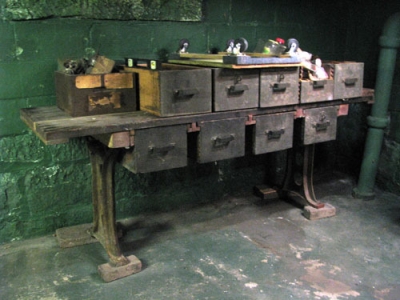
The full view of the workbench, now encumbered with drawers from another project.
Front low, with blocking for legs to avoid basement water.
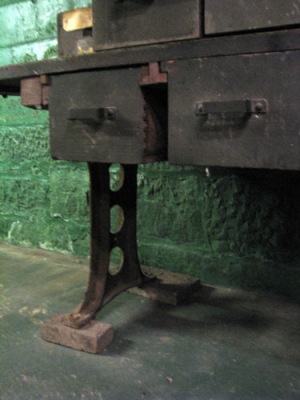
Yes, basement water. We're working on the external drainage to solve for that.
Top bolt deck assembly.
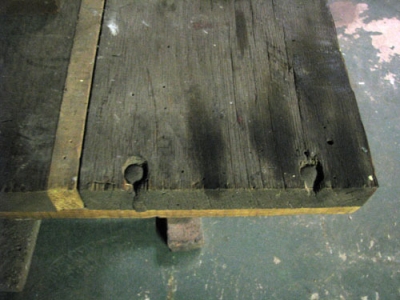
Done mostly in 2x6s, old, at real size - 1940s or 1950s, according to the woman we got it from - now tightened up, and WD40d where needed.
Legs on block and brick.
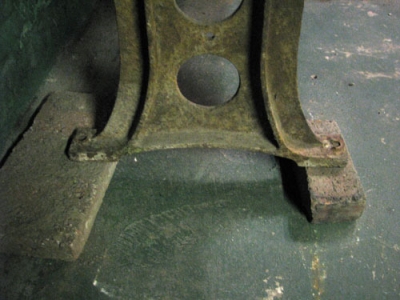
Homeowners a few iterations back understood basement drainage, if not how to keep the water out in the first place, so there's plenty of slope. The mismatched heights in brick and cinder below the bench account for that, and the bench is out from the wall to avoid contact with moisture.
8 vote(s)

Palindromedary
3
Mr Everyday
2
Ben [Sunshine]
2
Camel O'Rama
3
artmouse
3
Poisøn Lake
3
Juliette
5
Wolf
Terms
(none yet)6 comment(s)
Serious ....
That table is sweet ...
It must have been homemade....
1- the legs appear to be structural buttress supports from an early building or other early structural support...
2- The drawers are certainly from an old filing cabinet
3- the level of joinery in the drawers suggest early to mid 40's due to solid panels on bottom of drawer
A note - WD-40 is certainly not the cleaner that you want to use on this... Use WD-40 only if it gets wet as the 40 will displace the water.
A better option would be to use a wire cup brush to remove crap from the pits in the metal ...
Then use some kind of motorcycle cleaner - finisher.....then hit that bad boy with a coat of clear acryllic from a spray can
This process will truly show the beauty of those metal buttresses
The WD40 is for loosening nuts only - the nuts for the legs specifically. I'm being very careful not to get any on the wood itself.
The cleaner will be a brush wheel on a drill for the metal, to remove rust, and then the legs will be re-painted with factory standard industrial paint to match their initial use. I'm avoiding anything that really polishes them up, to keep the original use in mind.
The legs are steel mill bench legs from a local foundry/mill. That kind of leg was used in two functions - and the legs are actually missing the armature support which would have supported the main deck after having been bolted to the floor. The markings of the cuts are those of an Oxy-A rig.
Yep, and how I love 'em. They let me live on nearly no money, and hand things to other folks down the line.
indeed. craigslist has bestowed me with many wonderful things!











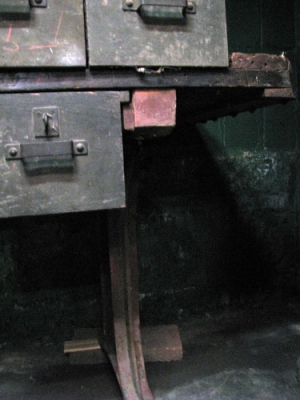
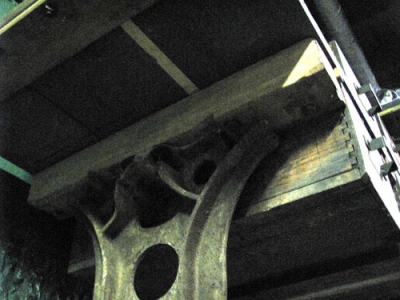



The pursuit of glass as treasure is nice.